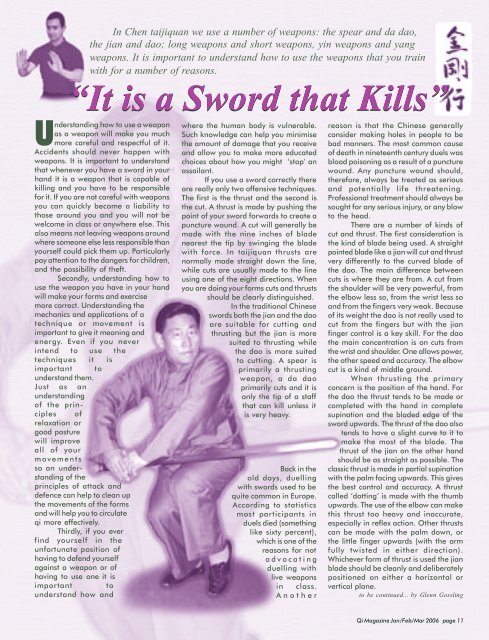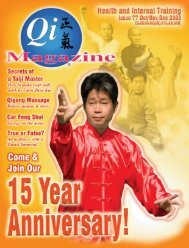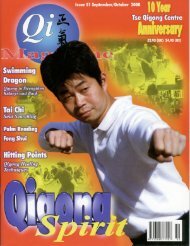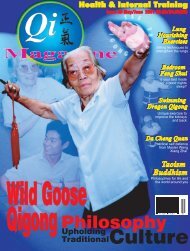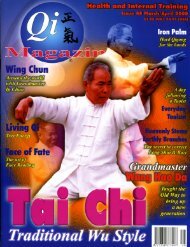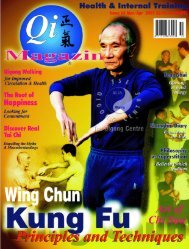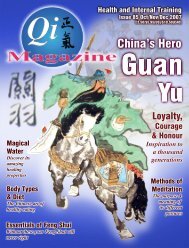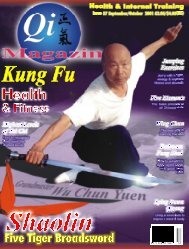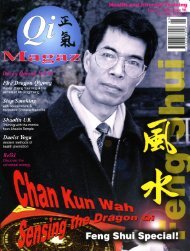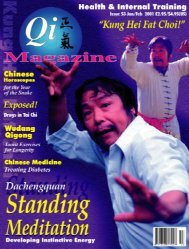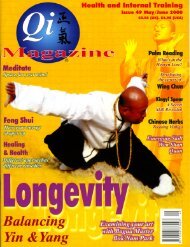Issue 78 - Tse Qigong Centre
Issue 78 - Tse Qigong Centre
Issue 78 - Tse Qigong Centre
- TAGS
- issue
- qigong
- qimagazine.com
You also want an ePaper? Increase the reach of your titles
YUMPU automatically turns print PDFs into web optimized ePapers that Google loves.
In Chen taijiquan we use a number of weapons: the spear and da dao,<br />
the jian and dao; long weapons and short weapons, yin weapons and yang<br />
weapons. It is important to understand how to use the weapons that you train<br />
with for a number of reasons.<br />
“It is a Sword that Kills”<br />
Understanding how to use a weapon<br />
as a weapon will make you much<br />
more careful and respectful of it.<br />
Accidents should never happen with<br />
weapons. It is important to understand<br />
that whenever you have a sword in your<br />
hand it is a weapon that is capable of<br />
killing and you have to be responsible<br />
for it. If you are not careful with weapons<br />
you can quickly become a liability to<br />
those around you and you will not be<br />
welcome in class or anywhere else. This<br />
also means not leaving weapons around<br />
where someone else less responsible than<br />
yourself could pick them up. Particularly<br />
pay attention to the dangers for children,<br />
and the possibility of theft.<br />
Secondly, understanding how to<br />
use the weapon you have in your hand<br />
will make your forms and exercise<br />
more correct. Understanding the<br />
mechanics and applications of a<br />
technique or movement is<br />
important to give it meaning and<br />
energy. Even if you never<br />
intend to use the<br />
techniques it is<br />
important to<br />
understand them.<br />
Just as an<br />
understanding<br />
of the principles<br />
of<br />
relaxation or<br />
good posture<br />
will improve<br />
all of your<br />
m ovement s<br />
so an understanding<br />
of the<br />
principles of attack and<br />
defence can help to clean up<br />
the movements of the forms<br />
and will help you to circulate<br />
qi more effectively.<br />
Thirdly, if you ever<br />
find yourself in the<br />
unfortunate position of<br />
having to defend yourself<br />
against a weapon or of<br />
having to use one it is<br />
important to<br />
understand how and<br />
where the human body is vulnerable.<br />
Such knowledge can help you minimise<br />
the amount of damage that you receive<br />
and allow you to make more educated<br />
choices about how you might ‘stop’ an<br />
assailant.<br />
If you use a sword correctly there<br />
are really only two offensive techniques.<br />
The first is the thrust and the second is<br />
the cut. A thrust is made by pushing the<br />
point of your sword forwards to create a<br />
puncture wound. A cut will generally be<br />
made with the nine inches of blade<br />
nearest the tip by swinging the blade<br />
with force. In taijiquan thrusts are<br />
normally made straight down the line,<br />
while cuts are usually made to the line<br />
using one of the eight directions. When<br />
you are doing your forms cuts and thrusts<br />
should be clearly distinguished.<br />
In the traditional Chinese<br />
swords both the jian and the dao<br />
are suitable for cutting and<br />
thrusting but the jian is more<br />
suited to thrusting while<br />
the dao is more suited<br />
to cutting. A spear is<br />
primarily a thrusting<br />
weapon, a da dao<br />
primarily cuts and it is<br />
only the tip of a staff<br />
that can kill unless it<br />
is very heavy.<br />
Back in the<br />
old days, duelling<br />
with swords used to be<br />
quite common in Europe.<br />
According to statistics<br />
most participants in<br />
duels died (something<br />
like sixty percent),<br />
which is one of the<br />
reasons for not<br />
a d v o c a t i n g<br />
duelling with<br />
live weapons<br />
in class.<br />
A n o t h e r<br />
reason is that the Chinese generally<br />
consider making holes in people to be<br />
bad manners. The most common cause<br />
of death in nineteenth century duels was<br />
blood poisoning as a result of a puncture<br />
wound. Any puncture wound should,<br />
therefore, always be treated as serious<br />
and potentially life threatening.<br />
Professional treatment should always be<br />
sought for any serious injury, or any blow<br />
to the head.<br />
There are a number of kinds of<br />
cut and thrust. The first consideration is<br />
the kind of blade being used. A straight<br />
pointed blade like a jian will cut and thrust<br />
very differently to the curved blade of<br />
the dao. The main difference between<br />
cuts is where they are from. A cut from<br />
the shoulder will be very powerful, from<br />
the elbow less so, from the wrist less so<br />
and from the fingers very weak. Because<br />
of its weight the dao is not really used to<br />
cut from the fingers but with the jian<br />
finger control is a key skill. For the dao<br />
the main concentration is on cuts from<br />
the wrist and shoulder. One allows power,<br />
the other speed and accuracy. The elbow<br />
cut is a kind of middle ground.<br />
When thrusting the primary<br />
concern is the position of the hand. For<br />
the dao the thrust tends to be made or<br />
completed with the hand in complete<br />
supination and the bladed edge of the<br />
sword upwards. The thrust of the dao also<br />
tends to have a slight curve to it to<br />
make the most of the blade. The<br />
thrust of the jian on the other hand<br />
should be as straight as possible. The<br />
classic thrust is made in partial supination<br />
with the palm facing upwards. This gives<br />
the best control and accuracy. A thrust<br />
called ‘dotting’ is made with the thumb<br />
upwards. The use of the elbow can make<br />
this thrust too heavy and inaccurate,<br />
especially in reflex action. Other thrusts<br />
can be made with the palm down, or<br />
the little finger upwards (with the arm<br />
fully twisted in either direction).<br />
Whichever form of thrust is used the jian<br />
blade should be cleanly and deliberately<br />
positioned on either a horizontal or<br />
vertical plane.<br />
to be continued... by Glenn Gossling<br />
Qi Magazine Jan/Feb/Mar 2006 page 11


